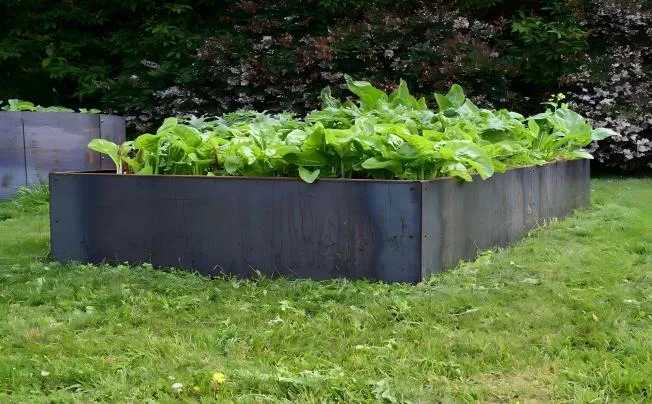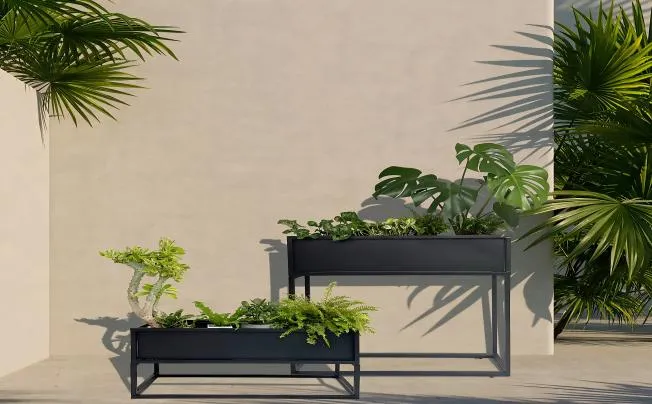How Do You Prevent Metal Planters From Rusting?
Rusting of metal flower pots is a common problem with a variety of causes.
Common anti-rust materials
Stainless steel, weathering steel, aluminium alloy, and other metals are common anti-rust materials.
Anti-corrosion coatings, such as electrophoretic and electroplating coatings, are the primary means of preventing rusting in aluminium alloy materials. The electrophoretic coating creates an anti-corrosion coating that is 5–25 microns thick by combining pigment, diluent, and surfactant in a chemical solution and applying it to the aluminium alloy's surface. It has a consistent thickness, strong corrosion resistance, and the ability to successfully stop oxidant corrosion. On the aluminium alloy's surface, the electroplating coating creates a metal film that is smooth, strong, corrosion-resistant, and comes in a variety of colours. The film is between three and two hundred microns thick. Additionally, a thick passivation layer can be created on the aluminium surface to enhance its anti-corrosion and anti-rust properties.
The anti-rust basis of stainless steel is to add chromium elements to generate a chromium oxide protective coating on the surface of the steel, which effectively inhibits the contact between the steel and the air and prevents oxygen from entering the steel to induce chemical reactions. However, stainless steel will also rust if the surface protective coating is broken.
Between regular steel and stainless steel, weathering steel is a low-alloy steel series. A thick and extremely sticky oxide layer is created between the rust layer and the steel matrix by mixing regular carbon steel with a certain quantity of copper and corrosion-resistant elements like phosphorus, chromium, nickel, titanium, and vanadium. This oxide layer can protect the matrix beneath the rust layer, slow down the pace of corrosion, and prevent oxygen and water from the atmosphere from penetrating the matrix.

Practical anti-rust tips and methods
The first step is to keep the metal flower pot's surface clean and dry. After each use, wipe it down with a fresh, soft cloth to remove any dust, water stains, or other debris. If the flower pot has rust on its surface, it should be handled quickly to stop the rust from spreading. Don't leave the flower pot in a humid area for an extended period of time. The corroded areas can be carefully polished with sandpaper and then cleaned with a moist cloth. At the same time, avoid using alkaline or acidic detergents to clean metal flower pots as they might accelerate rust and erode the metal surface. Using a mild neutral detergent and carefully rinsing with clean water is the best option.
2. One efficient way to stop rust is to apply coating protection. The metal flower pot's surface can be painted to prevent rust. Select high-quality anti-rust paint with good adhesion, then apply it evenly as directed by the product's instructions. To improve the adherence of the anti-rust paint, pre-treat the flower pot's surface to make sure it is smooth and clean. You can use anti-rust oil in addition to anti-rust paint. To create a protective layer that keeps moisture and air out of the flower pot, apply the anti-rust oil to its outside. To increase the anti-rust properties of certain small metal flower pots, a coating of metal that is difficult to rust, such zinc, chromium, etc., can be electroplated onto the surface.
3. Altering the metal structure is another way to prevent rust. The anti-rust properties of metal materials, such stainless steel, have been significantly enhanced by the addition of elements like nickel and chromium to create alloys. If the anti-rust feature is important to you while selecting a metal flower pot, you can prioritise stainless steel flower pots. In order to create a stable protective layer that keeps moisture and oxygen from coming into contact with the metal, chemical techniques like passivation treatment can also be employed to create a dense oxide film on the metal surface.

Anti-rust strategies in different scenarios
Metal flower pots must be maintained differently for indoor and outdoor settings, which have varied requirements for rust protection.
Daily cleaning still needs to be done, even if the inside atmosphere is very stable with only minor variations in temperature and humidity. To get rid of dust and stains, periodically wipe the metal flower pots with a gentle, moist cloth. To avoid scratches on the surface coating and compromising the rust protection action, keep the flower pots away from sharp objects. A humidifier can be used effectively to maintain the air humidity within a certain range if the indoor air is generally dry. This will stop the metal from producing static electricity as a result of excessive dryness, adsorbing dust, and speeding up rust.
Metal flower pots have additional difficulties in the complicated and variable outside environment. To prevent water buildup in wet regions, make sure the flower pots have an adequate drainage system. The flower container can be raised for drainage by adding a few small stones or bricks to the bottom. The flower pots can be temporarily moved indoors or to a protected area in the event of intense rain. Long-term exposure to the sun will raise the metal surface's temperature and hasten oxidation in regions with intense sunlight.
To avoid direct sunlight, the flower pots might be positioned in a somewhat shaded area. Additionally, some metal flower pots may cause surface coating cracking due to thermal expansion and contraction in the winter if the outside temperature is low. To provide protection, you can now cover the flower pot's surface with a layer of thermal insulation material, such as cotton fabric, foam plastic, etc.

Selected Blogs
-
What customization services are available for metalworking customization?
2024-12-12
-
What Is The Difference Between A Plant Container And A Raised Bed?
2024-04-23
-
Garden Screening & Fence Panels
2024-04-23
-
Gardening pot selection tips
2024-04-17
-
The function and collocation of horticultural fire pot
2024-04-17


